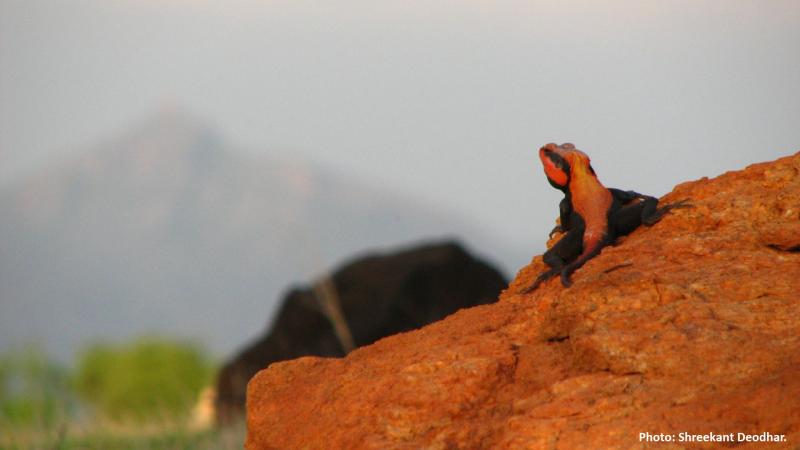
A walk in the rocky hills or on the city outskirts of Southern India is sure to reward you with a glimpse of a brightly coloured lizard basking in the sun. Also called the Peninsular Rock Agama (Psammophilus dorsalis), the attractive colours of the males—sometimes a deep red or a striking orange or even a pale patchy yellow—can change within seconds. They could also show you a piece of their push-ups or head bobs, all from their rocky perches. But, what lies behind their vibrant looks and choreographed moves? In a new study, Shreekant Deodhar and Kavita Isvaran from the Indian Institute of Science, Bengaluru, have tried to decode the meaning of the various behavioural signals exhibited by these drop-dead gorgeous male lizards.
“Agamas are relatively easy to observe and to tag and follow in the wild. They only live for about a year; hence we can follow them over large parts of their lives, and possibly even study several generations over a few years. But we’ve only recently begun to understand them”, says Shreekant Deodhar, the lead author of the study, talking about why they chose these attractive agamas.
The study was recently published in the journal Frontiers in Ecology and Evolution and is funded by the IISc-DBT Partnership Programme, the Department of Science and Technology and the Ministry of Human Resource Development.
For the study, the researchers tagged and observed 41 male rock agamas over their lifetime in Rishi Valley, Andhra Pradesh. Although they are frequently sighted, scientists do not know much about their behaviour. As the first step of their study, the researchers had to understand the wide range of display behaviours of these agamas.
“We soon discovered that the males showed multiple behaviours, like doing push-ups and flashing an orange colour at the same time”, recollects Deodhar.
The researchers then probed to know what is behind these multiple signals, and who are these lizards signalling to. They found that the primary reason was finding their lady love!
“It is something like having a car and a big house, which can quickly “advertise” to others that you are wealthy and healthy”, jokes Deodhar.
They observed that the frequency of the signals in male agamas increased when there were females around.
“Multiple signals could indicate that the lizard is of greater quality—perhaps an effort to be ‘Mr. Right’”, he adds.
There is more to these colours than just wooing females. The researchers found some evidence to show that if there were rival males in their vicinity, the agamas changed their hue to a pale yellow. However, if there was a close encounter with another male, these agamas donned their ‘fighting colours’— a combination of red and yellow.
The colours also help these lizards save their lives, the study found. In the presence of predators like monitor lizards or the Indian fox, the males quickly modulate their colours, turning pale, so to not attract their unwanted attention. Although more research is required in this area, it is possible that agamas display different behaviours to signal different things to different receivers, and also know when to lay low and not to get eaten!

The researchers then tried to understand if multiple signals helped the agamas acquire more mates and produce more babies—a measure of their ‘fitness’—by measuring each agama's ‘breeding tenure’. The breeding tenure is the duration for which the males sit on the rocks during the breeding season from May-September. The researchers also measured the number of females each male had access to per day. The longer the male stays on the rock, higher the number of females it has access to and is more likely to sire more offsprings. The researchers observed that the males that signalled more had longer tenures and therefore might have greater ‘fitness’.
One finding that surprised the researchers was that smaller lizards that were at the beginning of their breeding tenure were able to forge a territory with more females than the larger ones. The researchers believe that if smaller males, which are usually younger, can defend their territory from older males, then they could be of stronger and more fit.
This study is a part of an ongoing long-term project on the agamas, one of the very few of its kind from India. Using long-term monitoring of wild individuals, this particular study helps in understanding how fitness among males is influenced by their behaviour, providing a rare glimpse of how the pressures of natural and sexual selection play out in the natural world.
Here is a video footage of the multiple signalling observed in the male agamas.
[Video credits: Shreekant Deodhar]






